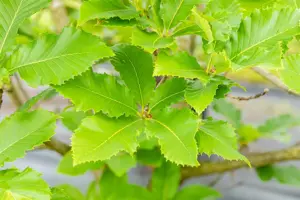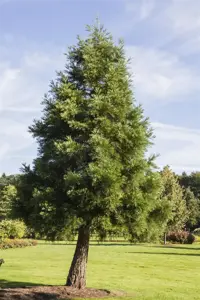Berberis thunb. 'Golden Horizon' - P9
Berberis thunb. 'Golden Horizon' - P9
Description
These produce red fruits from September onwards, which keep for a very long time.
Synonym
Synonyms (botanical): Berberis thunbergii 'HoHo 2'.
Bulletpoints
* fruit ornamentation
* beautiful foliage
* suitable for flowering hedges
* the blossoms are highly favoured by bees, bumblebees and hoverflies
* attractive orange autumn colouring
* tolerates pruning
* easy to care for
* drought-resistant, resistant to urban climates, wind-resistant, deer-resistant
Leaves
High foliage ornamental value. Attractive orange autumn colouring.
Growth habit
Japanese barberry 'Golden Horizon'® is dense, overhanging, branched and broad in structure.
Water
The plant has a medium water requirement.
Pruning
This plant is tolerant of pruning.
Location
Preferred location in a sunny to semi-shady position.
Soil
Berberis thunbergii 'Golden Horizon'® thrives on all acidic, humus-rich and sufficiently moist soils.
Planting time
Container plants can be planted all year round, except when the soil is frozen and in summer heat (over 30°C).
Tasks
- Mulching: In the period from March to April.
Care
A slow-release fertiliser can be used in spring. This releases the nutrients slowly and continuously so that the plant is evenly supplied over a longer period of time.
Flower
The yellow flowers appear in May.
fruit
The red fruits of Berberis thunbergii 'Golden Horizon'® are particularly decorative. These appear from September. Adhere for a very long time.
Interesting facts
Plant or parts of the plant are poisonous.
Use
Ornamental shrub, bee pasture, hedge
Shoots
The shoots of Berberis thunbergii 'Golden Horizon'® are spiny.
Root
Berberis thunbergii 'Golden Horizon'® is a shallow-rooted plant and, depending on the soil, forms densely branched roots.
- Article number158
-
EAN codeBETGHORI-0P9
- Latin nameBerberis thunb. 'Golden Horizon'
- catalogLandscape shop



